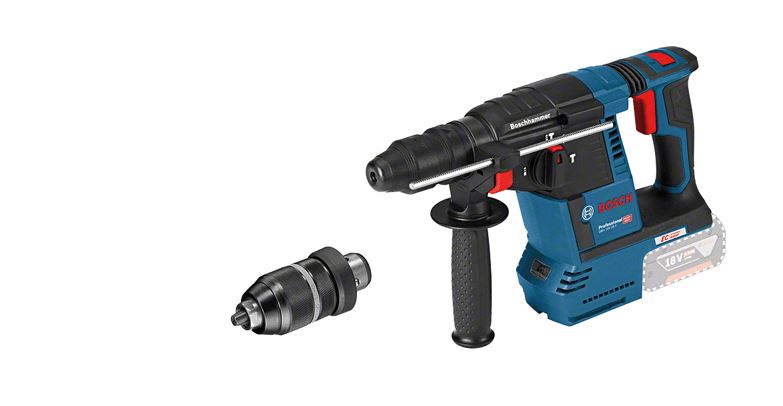BOSCH GBH 18V-26 F Cordless Rotary Hammer Instruction
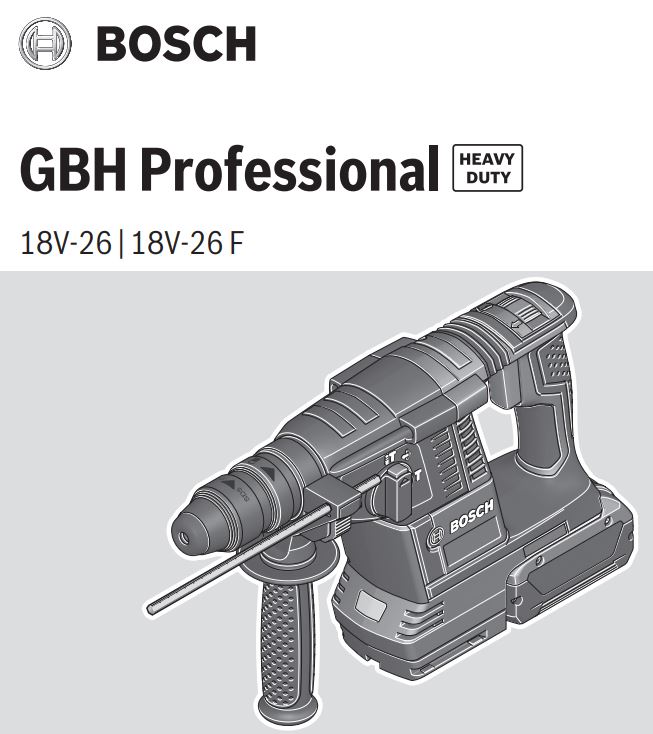
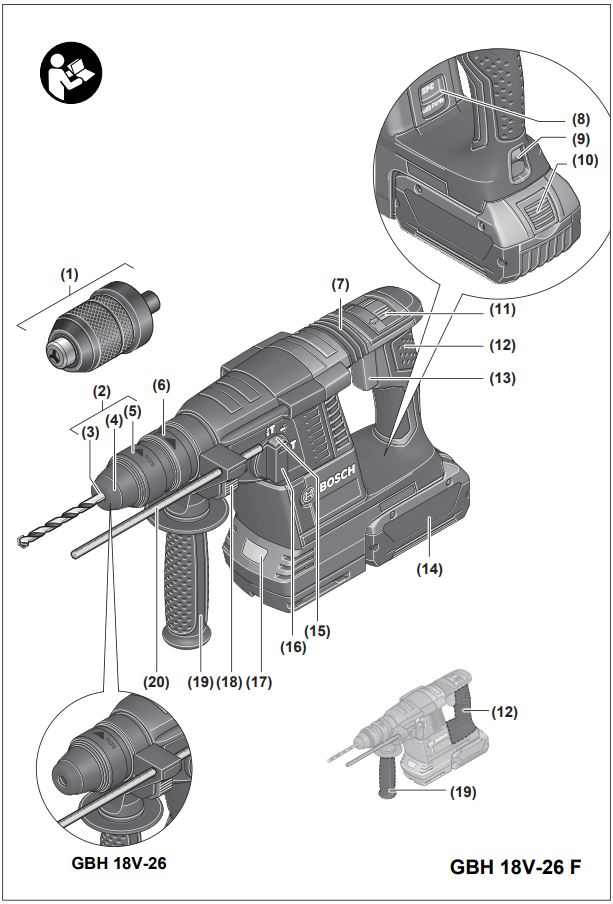


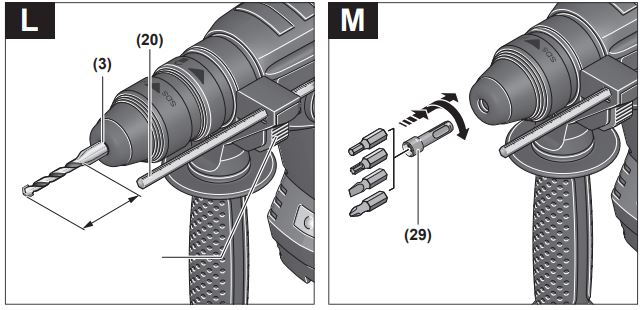
Safety instructions
General Power Tool Safety Warnings
⚠ WARNING
Read all safety warnings and all instructions. Failure to follow the warnings and instructions may result in electric shock, fire and/or serious injury.
Save all warnings and instructions for future reference.
The term “power tool” in the warnings refers to your mains operated (corded) power tool or battery-operated (cord-less) power tool.
Work area safety
- Keep work area clean and well lit. Cluttered or dark areas invite accidents.
- Do not operate power tools in explosive atmospheres, such as in the presence of flammable liquids, gases or dust. Power tools create sparks which may ignite the dust or fumes.
- Keep children and bystanders away while operating a power tool. Distractions can cause you to lose control.
Electrical safety
- Power tool plugs must match the outlet. Never modify the plug in any way. Do not use any adapter plugs with earthed (grounded) power tools. Unmodified plugs and matching outlets will reduce risk of electric shock.
- Avoid body contact with earthed or grounded surfaces, such as pipes, radiators, ranges and refrigerators. There is an increased risk of electric shock if your body is earthed or grounded.
- Do not expose power tools to rain or wet conditions. Water entering a power tool will increase the risk of electric shock.
- Do not abuse the cord. Never use the cord for carrying, pulling or unplugging the power tool. Keep cord away from heat, oil, sharp edges or moving parts. Damaged or entangled cords increase the risk of electric shock.
- When operating a power tool outdoors, use an extension cord suitable for outdoor use. Use of a cord suitable for outdoor use reduces the risk of electric shock..
- If operating a power tool in a damp location is unavoidable, use a residual current device (RCD) protected supply. Use of an RCD reduces the risk of electric shock.
Personal safety
- Stay alert, watch what you are doing and use common sense when operating a power tool. Do not use a power tool while you are tired or under the influence of drugs, alcohol or medication. A moment of inattention while operating power tools may result in serious personal injury.
- Use personal protective equipment. Always wear eye protection. Protective equipment such as dust mask, non-skid safety shoes, hard hat, or hearing protection used for appropriate conditions will reduce personal injuries.
- Prevent unintentional starting. Ensure the switch is in the off-position before connecting to power source and/or battery pack, picking up or carrying the tool. Carrying power tools with your finger on the switch or energising power tools that have the switch on invites accidents.
- Remove any adjusting key or wrench before turning the power tool on. A wrench or a key left attached to a rotating part of the power tool may result in personal injury.
- Do not overreach. Keep proper footing and balance at all times. This enables better control of the power tool in unexpected situations.
- Dress properly. Do not wear loose clothing or jewellery. Keep your hair, clothing and gloves away from moving parts. Loose clothes, jewellery or long hair can be caught in moving parts.
- If devices are provided for the connection of dust extraction and collection facilities, ensure these are connected and properly used. Use of dust collection can reduce dust-related hazards.
Power tool use and care
- Do not force the power tool. Use the correct power tool for your application. The correct power tool will do the job better and safer at the rate for which it was designed.
- Do not use the power tool if the switch does not turn it on and off. Any power tool that cannot be controlled with the switch is dangerous and must be repaired.
- Disconnect the plug from the power source and/or the battery pack from the power tool before making any adjustments, changing accessories, or storing power tools. Such preventive safety measures reduce the risk of starting the power tool accidentally.
- Store idle power tools out of the reach of children and do not allow persons unfamiliar with the power tool or these instructions to operate the power tool. Power tools are dangerous in the hands of untrained users.
- Maintain power tools. Check for misalignment or binding of moving parts, breakage of parts and any other condition that may affect the power tool’s operation. If damaged, have the power tool repaired before use. Many accidents are caused by poorly maintained power tools.
- Keep cutting tools sharp and clean. Properly maintained cutting tools with sharp cutting edges are less likely to bind and are easier to control.
- Use the power tool, accessories and tool bits etc. in accordance with these instructions, taking into account the working conditions and the work to be performed. Use of the power tool for operations different from those intended could result in a hazardous situation.
Battery tool use and care
- Recharge only with the charger specified by the manufacturer. A charger that is suitable for one type of battery pack may create a risk of fire when used with another battery pack.
- Use power tools only with specifically designated battery packs. Use of any other battery packs may create a risk of injury and fire.
- When battery pack is not in use, keep it away from other metal objects, like paper clips, coins, keys, nails, screws or other small metal objects, that can make a connection from one terminal to another. Shorting the battery terminals together may cause burns or a fire.
- Under abusive conditions, liquid may be ejected from the battery; avoid contact. If contact accidentally occurs, flush with water. If liquid contacts eyes, additionally seek medical help. Liquid ejected from the battery may cause irritation or burns.
Service
- Have your power tool serviced by a qualified repair person using only identical replacement parts. This will ensure that the safety of the power tool is maintained.
Hammer Safety Warnings
- Wear ear protectors. Exposure to noise can cause hearing loss.
- Use auxiliary handle(s), if supplied with the tool. Loss of control can cause personal injury.
- Hold power tool by insulated gripping surfaces when performing an operation where the cutting accessory or fastener may contact hidden wiring. Cutting accessory and fasteners contacting a “live” wire may make exposed metal parts of the power tool “live” and could give the operator an electric shock.
- Use suitable detectors to determine if there are hidden supply lines or contact the local utility company for assistance. Contact with electric cables can cause fire and electric shock. Damaging gas lines can lead to explosion. Breaking water pipes causes property damage.
- Always wait until the power tool has come to a complete stop before placing it down. The application tool can jam and cause you to lose control of the power tool.
- Secure the workpiece. A workpiece clamped with clamping devices or in a vice is held more secure than by hand.
- In case of damage and improper use of the battery, vapours may be emitted. The battery can set alight or explode. Ensure the area is well ventilated and seek medical attention should you experience any adverse effects. The vapours may irritate the respiratory system.
- Do not open the battery. There is a risk of short-circuiting.
- The battery can be damaged by pointed objects such as nails or screwdrivers or by force applied externally. An internal short circuit may occur, causing the battery to burn, smoke, explode or overheat.
- Only use the battery with products from the manufacturer. This is the only way in which you can protect the battery against dangerous overload.
 Protect the battery against heat, e.g. against continuous intense sunlight, fire, dirt, water and moisture. There is a risk of explosion and short-circuiting.
Protect the battery against heat, e.g. against continuous intense sunlight, fire, dirt, water and moisture. There is a risk of explosion and short-circuiting.
- Hold the power tool firmly with both hands and make sure you have a stable footing. The power tool can be more securely guided with both hands.
Product Description and Specifications
Read all the safety and general instructions. Failure to observe the safety and general instructions may result in electric shock, fire and/or serious injury. Please observe the illustrations at the beginning of this operating manual.
Intended Use
The power tool is intended for hammer drilling in concrete, brick and stone, as well as for light chiselling work. It is also suitable for drilling without impact in wood, metal, ceramic and plastic. Power tools with electronic control and right/left rotation are also suitable for screwdriving.
Product Features
The numbering of the product features refers to the diagram of the power tool on the graphics page.
- Keyless quick-change chuck (GBH 18V-26 F)
- SDS plus quick-change chuck (GBH 18V-26 F)
- SDS plus tool holder
- Dust protection cap
- Locking sleeve
- Locking ring for quick-change chuck (GBH 18V-26 F)
- Vibration damping
- EPC switch (Electronic Precision Control)
- Mounting for suspension strap
- Battery release button A)
- Rotational direction switch
- Handle (insulated gripping surface)
- On/off switch
- Battery A)
- Release button for impact/mode selector switch
- Impact/mode selector switch
- Worklight
- Button for depth stop adjustment
- Auxiliary handle (insulated gripping surface)
- Depth stop
- Securing screw for keyed chuck (GBH 18V-26)A)
- Keyed chuck (GBH 18V-26)A)
- SDS plus shank for drill chuck (GBH 18V-26)A)
- Drill chuck holder (GBH 18V-26 F)
- Identification grooves
- Chuck key (GBH 18V-26)
- Front sleeve of the keyless quick-change chuck (GBH 18V-26 F)
- Retaining ring of the keyless quick-change chuck (GBH 18V-26 F)
- Universal holder with SDS plus shankA)
A) Accessories shown or described are not included with the product as standard. You can find the complete selection of accessories in our accessories range.
Technical Data


Noise/Vibration Information
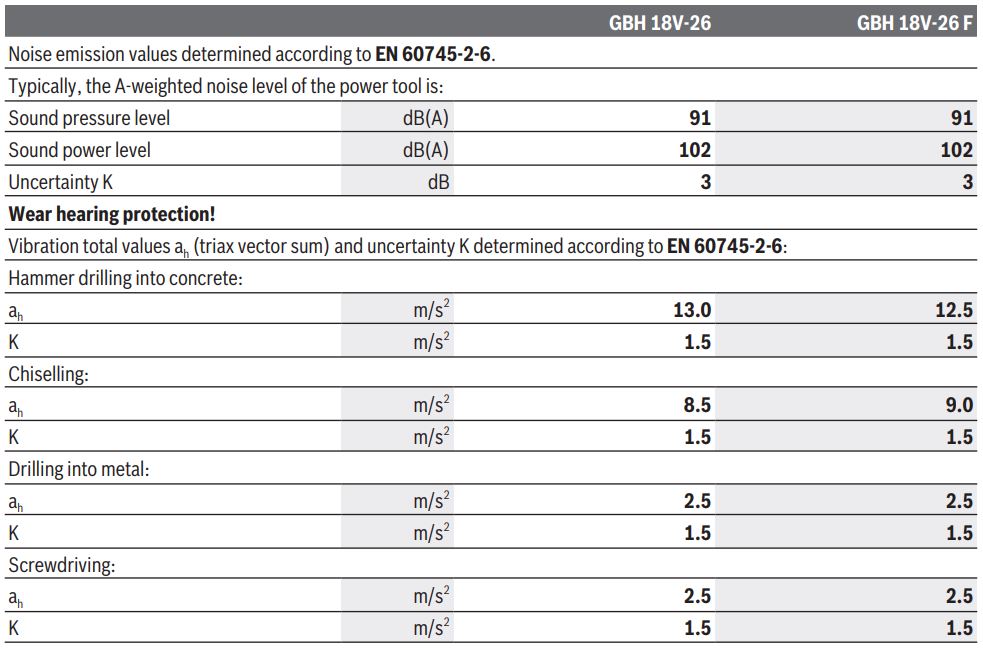
The vibration level and noise emission value given in these instructions have been measured in accordance with a standardised measuring procedure and may be used to compare power tools. They may also be used for a preliminary estimation of vibration and noise emissions. The stated vibration level and noise emission value represent the main applications of the power tool. However, if the power tool is used for other applications, with different application tools or is poorly maintained, the vibration level and noise emission value may differ. This may significantly increase the vibration and noise emissions over the total working period. To estimate vibration and noise emissions accurately, the times when the tool is switched off or when it is running but not actually being used should also be taken into account. This may significantly reduce vibration and noise emissions over the total working period. Implement additional safety measures to protect the operator from the effects of vibration, such as servicing the power tool and application tools, keeping their hands warm, and organising workflows correctly.
Assembly
- Before any work on the tool (e.g. maintenance, tool change etc.) as well as during transport and storage, set the rotational direction switch to the middle position. There is risk of injury from unintentionally pressing the on/off switch.
Battery Charging
- Use only the chargers listed in the technical data. Only these chargers are matched to the lithium-ion battery of your power tool.
Note: The battery is supplied partially charged. To ensure full battery capacity, fully charge the battery in the charger before using your power tool for the first time.
The lithium-ion battery can be charged at any time without reducing its service life. Interrupting the charging process does not damage the battery. The lithium-ion battery is protected against deep discharge by the “Electronic Cell Protection (ECP)”. When the battery is discharged, the power tool is switched off by means of a protective circuit: The application tool no longer rotates. u Do not continue to press the On/Off switch after the power tool has automatically switched off. The battery can be damaged. Follow the instructions on correct disposal.
Removing the battery
The battery (14) is equipped with two locking levels to prevent the battery from falling out if the battery release button (10) is pressed unintentionally. As long as the battery is inserted in the power tool, it is held in position by means of a spring. To remove the battery (14), press the release button (10) and pull the battery out of the power tool. Do not use force to do this.
Battery charge indicator
The green LEDs on the battery charge indicator indicate the state of charge of the battery. For safety reasons, it is only possible to check the state of charge when the power tool is not in operation. Press the button for the battery charge indicator or to show the state of charge. This is also possible when the battery is removed. If no LED lights up after pressing the button for the battery charge indicator, then the battery is defective and must be replaced.
Battery model GBA 18V…
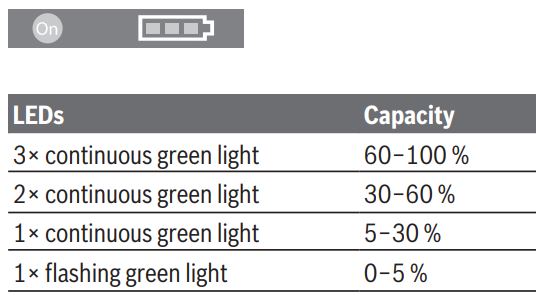
Battery model ProCORE18V…
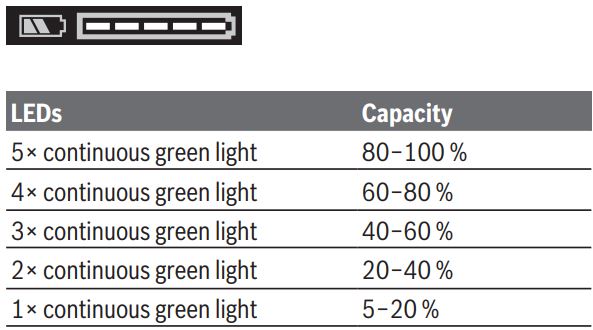
![]()
Auxiliary handle
Do not operate your power tool without the auxiliary handle (19).
Swivelling the auxiliary handle (see figure A) You can swivel the auxiliary handle (19) to any angle for a safe work posture that minimises fatigue. Turn the lower gripping end of the auxiliary handle (19) anticlockwise and swivel the auxiliary handle (19) into the required position. Then turn the lower gripping end of the auxiliary handle (19) clockwise to retighten it. Make sure that the retaining strap of the auxiliary handle slots into the corresponding groove of the housing.
Selecting Drill Chucks and Tools
Hammer drilling and chiselling require SDS-plus application tools that are inserted into the SDS-plus drill chuck. For drilling without impact in wood, metal, ceramic and plastic as well as for screwdriving, tools without SDSplus are used (e.g. cylindrical shank drill bits). For these tools, a keyless chuck or a keyed chuck are required.
Inserting/removing the keyed chuck (GBH 18V-26)
Fitting the keyed chuck (see figure B) Screw the SDS-plus shank (23) into a keyed chuck (22).
Secure the keyed chuck (22) using the securing screw (21). Note that the securing screw has a left-hand thread.
Inserting the keyed chuck (see figure B)
Clean and lightly grease the insertion end of the shank. Insert the keyed chuck with the adapter shank into the tool holder with a turning motion until it automatically locks. Check that it is locked by pulling the keyed chuck.
Removing the keyed chuck
Push the locking sleeve (5) back and remove the keyed chuck (22).
Removing/inserting the quick-change chuck
(GBH 18V-26 F)
Removing the Quick-Change Chuck (see figure C) Pull back on the quick-change chuck locking ring (6), hold it in this position and pull the SDS plus quick-change chuck (2) or the keyless quick-change chuck (1) out from the front. Once the quick-change chuck is removed, protect it from dirt.
Inserting the quick-change chuck (see figure D) u Use only model-specific original equipment and pay attention to the number of identification grooves (25). Only quick-change chucks with two or three identification grooves are permitted. If an unsuitable quick-change chuck is used, the application tool can fall out during operation. Before insertion, clean the quick-change chuck and lightly grease the shank. Wrap your whole hand around the SDS-plus quick-change chuck (2) or the keyless quick-change chuck (1). Use a turning motion to push the quick-change chuck into the drill chuck holder (24) until you hear it click into place. The quick-change chuck is automatically locked. Check that it is locked by pulling on the quick-change chuck.
Changing the Tool
The dust protection cap (4) largely prevents the penetration of drilling dust into the tool holder during operation. When inserting the tool, make sure that the dust protection cap (4) does not become damaged. u Replace a damaged dust protection cap immediately.
It is recommended that you have use an after-sales service for this.
Changing the tool (SDS plus)
Inserting the SDS plus application tool (see figure E) The SDS-plus drill chuck enables you to change the application tool easily and conveniently without needing to use additional tools. GBH 18V-26 F: Insert the SDS plus quick-change chuck (2). Clean and lightly grease the shank of the application tool. Insert the application tool into the tool holder while turning it until it locks automatically. Check that it is locked by pulling on the tool. As a requirement of the system, the SDS-plus application tool can move freely. This causes a certain radial run-out at no-load, which has no effect on the accuracy of the drill hole, as the drill bit centres itself upon drilling.
Removing SDS-plus application tools (see figure F) Push the locking sleeve (5) back and remove the application tool.
Changing the tool (without SDS plus)
(GBH 18V-26)
Inserting the application tool (see figure G) Note: Application tools that do not have SDS plus must not be used for hammer drilling or chiselling. Tools without SDS plus and their drill chucks are damaged by hammer drilling or chiselling. Insert a keyed chuck (22). Open the keyed chuck (22) by turning it until the tool can be inserted. Insert the tool. Insert the chuck key (26) into the corresponding holes of the keyed chuck (22) and clamp the tool evenly.
Turn the impact/mode selector switch (16) to the “drilling” position.
Removing the application tool (see figure H) Use the chuck key (26) to turn the sleeve of the keyed chuck (22) anticlockwise until the application tool can be removed.
Changing the tool (without SDS plus)
(GBH 18V-26 F)
Inserting the application tool (see figure I) Note: Application tools that do not have SDS plus must not be used for hammer drilling or chiselling. Tools without SDS plus and their drill chucks are damaged by hammer drilling or chiselling. Insert the keyless quick-change chuck (1). Hold the retaining ring (28) of the keyless quick-change chuck firmly in place. Open the tool holder by turning the front sleeve (27) until the tool can be inserted. Hold the retaining ring (28) in place and firmly tighten the front sleeve (27) by turning it in the direction of the arrow until you hear it click into place. Check that it is seated securely by pulling on the tool. Note: If the tool holder was unscrewed all the way, a scraping sound may be heard while retightening the tool holder and it may not fully tighten. In this case, turn the front sleeve (27) in the opposite direction to the arrow by one full turn. This will allow the tool holder to be fully tightened. Turn the impact/mode selector switch (16) to the “drilling” position.
Removing the application tool (see figure J) Hold the retaining ring (28) of the keyless quick-change chuck firmly in place. Open the tool holder by turning the front sleeve (27) in the direction of the arrow until the tool can be removed.
Dust/Chip Extraction
The dust from materials such as lead paint, some types of wood, minerals and metal can be harmful to human health. Touching or breathing in this dust can trigger allergic reactions and/or cause respiratory illnesses in the user or in people in the near vicinity. Certain dusts, such as oak or beech dust, are classified as carcinogenic, especially in conjunction with wood treatment additives (chromate, wood preservative). Materials containing asbestos may only be machined by specialists. Use a dust extraction system that is suitable for the material wherever possible. Provide good ventilation at the workplace. It is advisable to wear a P2 filter class breathing mask. The regulations on the material being machined that apply in the country of use must be observed.
Avoid dust accumulation at the workplace. Dust can easily ignite.
Dust extraction with GDE 18V-16 (accessory) (see figure K) The GDE 18V-16 dust extraction attachment (accessory) is required for extracting concrete dust and stone dust. This dust extraction system is not suitable for dust from wood, metal and plastic or for dust which is harmful to one’s health (e.g. asbestos).
Operation
Start-up
Inserting the Battery u Use only original Bosch lithium-ion batteries with the voltage stated on the type plate of your power tool. Using other batteries can lead to injuries and pose a fire hazard. Set the rotational direction switch (11) to the middle position to avoid unintentionally switching it on. Slide the battery (14) all the way into the battery bay . Setting the Operating Mode The operating mode of the power tool is selected using the impact/mode selector switch (16). To change the operating mode, press the release button (15) and turn the impact/mode selector switch (16) until it clicks into the required position. Note: Only change the operating mode when the power tool is switched off. Otherwise, the power tool may become damaged.

Setting the Rotational Direction
The rotational direction switch (11) is used to change the rotational direction of the power tool. However, this is not possible while the on/off switch (13) is being pressed.
- Only operate the rotational direction switch (11) when the power tool is not in use.
Always set the rotational direction to clockwise rotation for hammer drilling, drilling and chiselling.
Clockwise: Slide the rotational direction switch (11) all the way to the left.
Anticlockwise: Slide the rotational direction switch (11) all the way to the right.
Switching On and Off
To switch on the power tool, press the on/off switch
(13). The worklight (17) lights up when the on/off switch (13) is lightly or fully pressed, allowing the work area to be illuminated in poor lighting conditions. When switching on the power tool for the first time, the start may be slightly delayed as the power tool’s electronic system has to configure itself first. For low temperatures, the power tool reaches the full hammer/impact capacity only after a certain time. To switch off the power tool, release the on/off switch
(13).
Adjusting the Speed/Impact Rate
Adjust the speed/impact rate of the power tool when it is on by pressing in the on/off switch (13) to varying extents. Applying light pressure to the on/off switch (13) results in a low rotational speed/impact rate. Applying increasing pressure to the switch increases the speed/impact rate.
Electronic Precision Control (EPC)
EPC assists you when working with impact in sensitive materials by ensuring slow start-up and reduced operating speed.

Overload clutch
- If the application tool jams or snags, the power transmission to the drill spindle will be interrupted. Always hold the power tool firmly with both hands to withstand the forces this may create and adopt a position with stable footing.
- Switch the power tool off immediately and remove the application tool if the power tool becomes blocked. Switching on when the drilling tool is blocked may cause high torque reactions.
Rapid shut-off (KickBack Control)
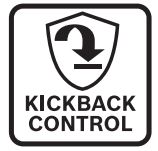 The rapid shut-off function (KickBack Control) gives the user greater control over the power tool and offers them better protection than power tools that do not have KickBack Control. The power tool will switch off if it suddenly and unforeseeably rotates around the drilling axis.
The rapid shut-off function (KickBack Control) gives the user greater control over the power tool and offers them better protection than power tools that do not have KickBack Control. The power tool will switch off if it suddenly and unforeseeably rotates around the drilling axis.
To switch the tool back on, release the on/off switch (13) and then press it again.
Rapid shut-off is indicated by flashing of the worklight (17) on the power tool.
Practical Advice
Setting the drilling depth (see figure L)
You can use the depth stop (20) to set the required drilling depth X. Press the button for depth stop adjustment (18) and in-sert the depth stop into the auxiliary handle (19). The fluting on the depth stop (20) must face downwards. Insert the SDS-plus application tool into the SDS-plus tool holder (3) to the stop. Otherwise, the movability of the SDS-plus drilling tool can lead to incorrect adjustment of the drilling depth. Pull the depth stop far enough out that the distance between the drill bit tip and the edge of the depth stop corresponds to the required drilling depth X.
Changing the chiselling position (Vario-Lock)
You can lock the chisel in 44 different positions, so you can select the optimum working position for each task. Insert the chisel into the tool holder. Turn the impact/mode selector switch (16) to the “Vario-Lock” position. Turn the application tool to the required chisel position. Turn the impact/mode selector switch (16) to the “chiselling” position. With this, the tool holder is locked. Set the rotational direction for chiselling to clockwise.
Inserting screwdriver bits (see figure M)
Only apply the power tool to the screw/nut when the
tool is switched off. Rotating tool inserts can slip off. A universal holder (29) with SDS-plus shank (accessory) is required to work with screwdriver bits. Clean and lightly grease the insertion end of the shank. Insert the universal holder into the tool holder while turning it until it locks automatically. Check that it is locked by pulling the universal holder. Insert a screwdriver bit in the universal holder. Only use screwdriver bits that fit the screw head. To remove the universal holder, slide the locking sleeve
(5) backwards and remove the universal holder (29) from the tool holder.
Vibration damping
The integrated vibration damping function reduces the generated vibration.
Do not continue to use the power tool if the damping element is damaged.
Recommendations for Optimal Handling of the Battery Protect the battery against moisture and water. Only store the battery within a temperature range of -20 to 50 °C. Do not leave the battery in your car in the summer, for example. Occasionally clean the ventilation slots on the battery using a soft brush that is clean and dry. A significantly reduced operating time after charging indicates that the battery has deteriorated and must be replaced. Follow the instructions on correct disposal.
Maintenance and Service
Maintenance and Cleaning
- Remove the battery from the power tool before carrying out work on the power tool (e.g. maintenance, changing tool, etc.). The battery should also be removed for transport and storage. There is risk of injury from unintentionally pressing the on/off switch.
- To ensure safe and efficient operation, always keep the power tool and the ventilation slots clean.
- Replace a damaged dust protection cap immediately. It is recommended that you have use an after-sales service for this.
Clean the tool holder (3) after each use.
After-Sales Service and Application Service
Our after-sales service responds to your questions concerning maintenance and repair of your product as well as spare parts. You can find explosion drawings and information on spare parts at: www.bosch-pt.com The Bosch product use advice team will be happy to help you with any questions about our products and their accessories. In all correspondence and spare parts orders, please always include the 10digit article number given on the nameplate of the product.
Australia, New Zealand and Pacific Islands
Robert Bosch Australia Pty. Ltd.
Power Tools
Locked Bag 66
Clayton South VIC 3169
Customer Contact Center
Inside Australia:
Phone: (01300) 307044
Fax: (01300) 307045
Inside New Zealand:
Phone: (0800) 543353
Fax: (0800) 428570
Outside AU and NZ:
Phone: +61 3 95415555
www.bosch-pt.com.au
www.bosch-pt.co.nz
Great Britain
Robert Bosch Ltd. (B.S.C.)
P.O. Box 98
Broadwater Park
North Orbital Road
Denham Uxbridge
UB 9 5HJ
At www.bosch-pt.co.uk you can order spare parts or arrange the collection of a product in need of servicing or repair.
Tel. Service: (0344) 7360109
E-Mail: boschservicecentre@bosch.com
Ireland
Origo Ltd.
Unit 23 Magna Drive
Magna Business Park
City West
Dublin 24
Tel. Service: (01) 4666700
Fax: (01) 4666888
Republic of South Africa
Customer service
Hotline: (011) 6519600
Gauteng – BSC Service Centre
35 Roper Street, New Centre
Johannesburg
Tel.: (011) 4939375
Fax: (011) 4930126
E-Mail: bsctools@icon.co.za
KZN – BSC Service Centre
Unit E, Almar Centre
143 Crompton Street
Pinetown
Tel.: (031) 7012120
Fax: (031) 7012446
E-Mail: bsc.dur@za.bosch.com
Western Cape – BSC Service Centre
Democracy Way, Prosperity Park
Milnerton
Tel.: (021) 5512577
Fax: (021) 5513223
E-Mail: bsc@zsd.co.za
Bosch Headquarters
Midrand, Gauteng
Tel.: (011) 6519600
Fax: (011) 6519880
E-Mail: rbsa-hq.pts@za.bosch.com
Armenia, Azerbaijan, Georgia
Robert Bosch Ltd.
David Agmashenebeli ave. 61
0102 Tbilisi, Georgia
Tel. +995322510073
www.bosch.com
Kyrgyzstan, Mongolia, Tajikistan, Turkmenistan, Uzbekistan TOO “Robert Bosch” Power Tools, After Sales Service Muratbaev Ave., 180 050012, Almaty, Kazakhstan Service Email: service.pt.ka@bosch.com
Official Website: www.bosch.com, www.bosch-pt.com
Transport
The contained lithium-ion batteries are subject to the Dangerous Goods Legislation requirements. The batteries are suitable for road-transport by the user without further restrictions. When shipping by third parties (e.g.: by air transport or forwarding agency), special requirements on packaging and labelling must be observed. For preparation of the item being shipped, consulting an expert for hazardous material is required. Dispatch battery packs only when the housing is undamaged. Tape or mask off open contacts and pack up the battery in such a manner that it cannot move around in the packaging. Please also observe the possibility of more detailed national regulations.
Disposal
![]() Power tools, rechargeable batteries, accessories and packaging should be sorted for environmental-friendly recycling. Do not dispose of power tools and batteries/rechargeable batteries into household waste!
Power tools, rechargeable batteries, accessories and packaging should be sorted for environmental-friendly recycling. Do not dispose of power tools and batteries/rechargeable batteries into household waste!
Only for EU countries: According to the Directive 2012/19/EU, power tools that are no longer usable, and according to the Directive 2006/66/EC, defective or used battery packs/batteries, must be collected separately and disposed of in an environmentally correct manner.
Battery packs/batteries: Li-ion: Please observe the notes in the section on transport (see “Transport”, page 24).

EU Declaration of Conformity
Cordless rotary hammer
Article number
We declare under our sole responsibility that the stated products comply with all applicable provisions of the directives and regulations listed below and are in conformity with the following standards.
Technical file at: *
![]()
